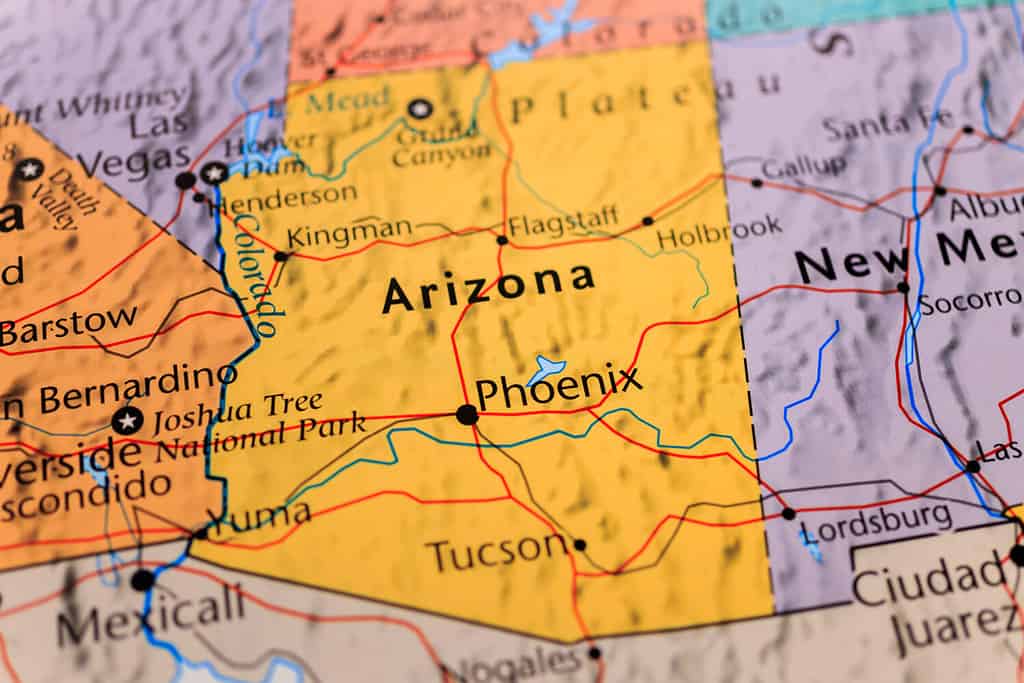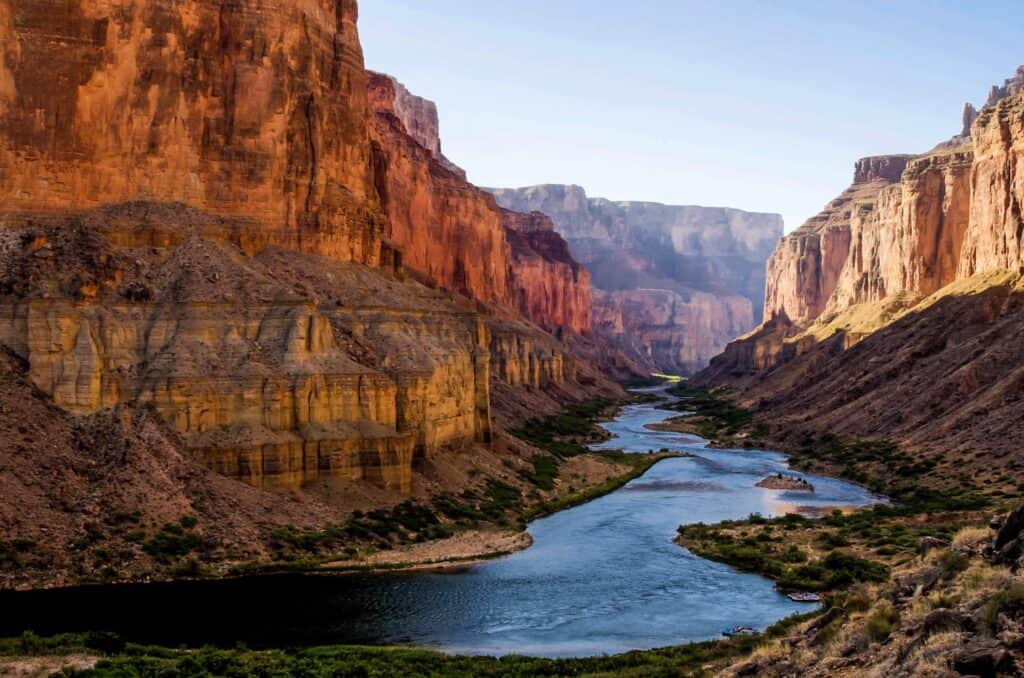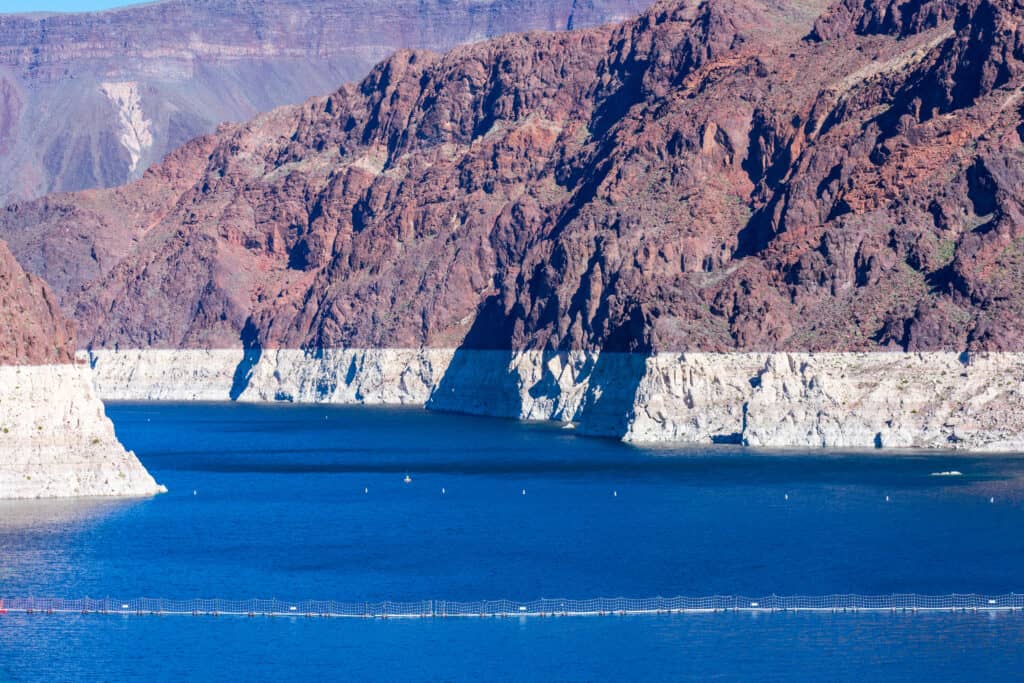Since the 1930s, Hoover Dam has provided electricity and water for people in the Southwestern United States. By taming the wild and unpredictable Colorado River and harnessing it for human purposes, the builders of Hoover Dam made the structure a symbol of settling America’s wild frontier. In this article, we’ll cover the height of the Hoover Dam. We’ll also learn how it was built, how it compares to other massive dams around the world, and how it serves the local economy.

Hoover Dam is visible on this map, to the east of Las Vegas on the Arizona border.
©Alexander Lukatskiy/Shutterstock.com
Why Was Hoover Dam Built?
The Colorado River was a problem for settlers in the southwestern part of the United States since the area was first settled. At dry times the river could reduce to a trickle and crops and livestock would die from lack of moisture. When the rain returned, sometimes far upstream, the river was subject to sudden, violent flash floods strong enough to shift large boulders and disastrously erode the land along its banks and tributaries, wrecking farmland.
Engineers knew that a dam would allow a controlled release of the water so that it would always stay at a predictable, steady rate downstream. Moreover, the electricity generated by the dam would help power industry and homes across a wide area that was still largely undeveloped. Lake Mead, which would result from the building of the dam, would be a recreation spot that would draw tourists and help build the economy of the area. And in the Great Depression of the late 1920s and 1930s, the government was looking for ways to put Americans to work. Large public works projects were one way of accomplishing this.

Hoover Dam controls violent seasonal flooding along the Colorado River.
©Beth Ruggiero-York/Shutterstock.com
Facts about the Building of Hoover Dam
- Construction lasted from 1931 to 1936.
- Building the dam required building a new town called Boulder, Nevada, for the 21,000 workers who labored on the project.
- Due to work-related accidents, 96 people died working on the dam. Contrary to myth, no one is buried in the cement.
- The dam was named after President Herbert Hoover, who was instrumental in launching the project.
- President Franklin D. Roosevelt dedicated it.
- It cost $49 million to build ($760 million in today’s money). The power plant and generators cost another $71 million.
- It took 3.3 million cubic yards of concrete to build it.
- Hoover Dam generated enough electricity for sale that by 1987 it completely paid for its own construction.

“High scalers” climbed the cliff to blast away loose boulders. This protected future workers below.
©Everett Collection/Shutterstock.com
How Big is Hoover Dam?
Here are some statistics about the size of Hoover Dam:
- At 726 feet tall, it is the second-tallest dam in the United States
- It is 660 feet thick at the base, which is nearly as long as two football fields.
- The top of the dam is 45 feet wide, as much as a four-lane highway.
- The dam curves, like an arch on its side. This makes it incredibly strong and redirects the force of the water behind it into the canyon walls.
- It produces 4 billion kilowatt-hours of hydroelectric power every year. This is enough for the needs of 1.3 million people.
- About half of the electricity goes to customers in California. The remainder divides between Nevada and Arizona.
- Hoover Dam is meant to last 2,000 years. However, with proper care, it could easily still exist 10,000 years from now.

Electricity from Hoover Dam keeps Las Vegas lit every night.
©iStock.com/RandyAndy101
How Does Hoover Dam Compare with Other Large Dams?
The Largest Dams in the United States by Height
| Name | State | Year Completed | Structure Height | Water Capacity |
| Oroville Dam | CA | 1968 | 770 ft. | 3.5 million acre feet |
| Hoover Dam | AZ-NV | 1936 | 726 ft. | 28.945 million acre feet |
| Dworshak Dam | ID | 1973 | 717 ft. | 3.56 million acre feet |
| Glen Canyon Dam | AZ | 1963 | 710 ft. | 26.2 million acre feet |
| New Bullards Bar Dam | MT | 1969 | 645 ft. | 996,103 acre feet |
The Largest Dams in the United States by Water Capacity
| Name | State | Year Completed | Structure Height | Water Capacity |
| Hoover Dam | AZ-NV | 1936 | 726 ft. | 28.945 million acre feet |
| Glen Canyon Dam | AZ | 1963 | 710 ft. | 26.2 million acre feet |
| Garrison Dam | ND | 1953 | 210 ft. | 23.8 million acre feet |
| Oahe Dam | SD | 1958 | 245 ft. | 23.137 acre feet |
| Fort Peck Dam | MT | 1940 | 250.5 ft. | 18.468 acre feet |

The curved shape of the dam makes it powerful enough to hold back millions of tons of water pressure.
©iStock.com/Sean Pavone
How Much Water Does Hoover Dam Provide?
Lake Mead, the reservoir created by Hoover Dam, is the largest artificial reservoir in the United States. When it’s full, it is 112 miles long, 532 feet deep, has a surface area of 247.1 square miles, and impounds 9.3 trillion gallons of water. However, due to years of drought and overuse of water for agriculture, the reservoir today is only 30% full. The dropping water level has revealed a lot of mysterious secrets, including sunken boats, lost cars, and several dead bodies, not all of whom died of natural causes.
The question of how to refill the reservoir isn’t an easy one. Some experts say it would take up to six years of above-average rain to completely refill it. Some people have proposed engineering schemes like pumping water over 1,000 miles from the Mississippi River to the Colorado River watershed. Technological solutions like this though would be fantastically expensive and take decades to complete. Regardless of the approach, most people agree that we need to redouble efforts to conserve and recycle water in the Southwest.

The light-colored ring around Lake Mead shows the sharp drop in water level in recent years.
©iStock.com/Michael Vi
What Can You Do at Hoover Dam and Lake Mead?
There are a lot of things to do at Hoover Dam. About a million visitors a year go there to tour the dam, learn about its construction, see its inner workings, and admire the art-deco style art and architecture of the facilities. Visitors can view the dam from the top and from the world’s tallest concrete arch bridge that towers above it.
The Lake Mead National Recreation Area protects the dam and the area surrounding the reservoir. At the recreation area guests can camp, hike, or hunt and fish with an Arizona or Nevada hunting or fishing license. And a short drive away is Las Vegas with all the entertainment anyone could want, all made possible by the amazing, hardworking Hoover Dam.
The photo featured at the top of this post is © Michal Plachy/Shutterstock.com
Thank you for reading! Have some feedback for us? Contact the AZ Animals editorial team.






